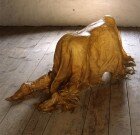Let's get physical: Antoni probes her body of work
How would Jesse Helms have reacted to artist Janine Antoni? Notorious for savaging the National Endowment of the Arts for supporting photographer Andres Serrano's submersion of a crucifix in urine, and performance artist Karen Finley's smearing her body with chocolate, the late senator was not high on "concept," especially when it involved the body and bodily fluids. So, the image of McArthur "genius grant"-winner Antoni peeing through a handheld copper gargoyle atop the Chrysler Building probably would have made Helms apoplectic.
Which is too bad because Antoni, whose exhibition "At Home in the Body" is currently on view at the University of Virginia Art Museum, is one of the most intellectually engaging artists working today. Using her body as an art-making instrument, she delves into issues of gender identity, nurturing, the mother-child relationship, and cultural ideals of femininity and beauty. She also includes subtle references to art history (e.g. in the way the photograph "One another" looks like a Dutch still life from a distance).
"At Home in the Body" comprises a selection of Antoni's work from the past 16 years. The earliest piece is "Tender Buttons," 1994, in which a black velvet case showcases twin gold pins, reminiscent of ancient Roman disc brooches. A closer look reveals they are casts of Antoni's nipples, and this sudden realization stirs ideas about beauty, ornamentation, and sexual taboos (what is hidden and revealed).
Because Antoni's pieces are process- and performance-oriented–- i.e. the act of making is as important as the result–- the objects displayed are often the physical evidence of more involved pieces. For example, the photograph "Lattice" and photo diptych "Host," which show a spider's web spanning a kitchen, are images documenting a 2009 project in which Antoni hung suspended in a web-like harness wearing a dollhouse as a skirt while a spider wove its home within the house alongside her legs.
Antoni's objects are often visually arresting. For the 2000 piece, "Saddle," she cast her body on all fours in plaster and draped the figure with a cowhide, hardening the pelt before removing the figure. The resulting translucent sculpture is at once compelling and repulsive, erotic and strange. One in a series of six, the version of "Saddle" in the current exhibition is noteworthy for its black fur where Antoni's feet would be.
Prudish critics may balk, but Antoni's body-fueled body of work is worthy of deep thought.
Janine Antoni's "At Home on the Body" is on view through June 13, at the University of Virginia Art Museum. 155 Rugby Road. 924-3592.
